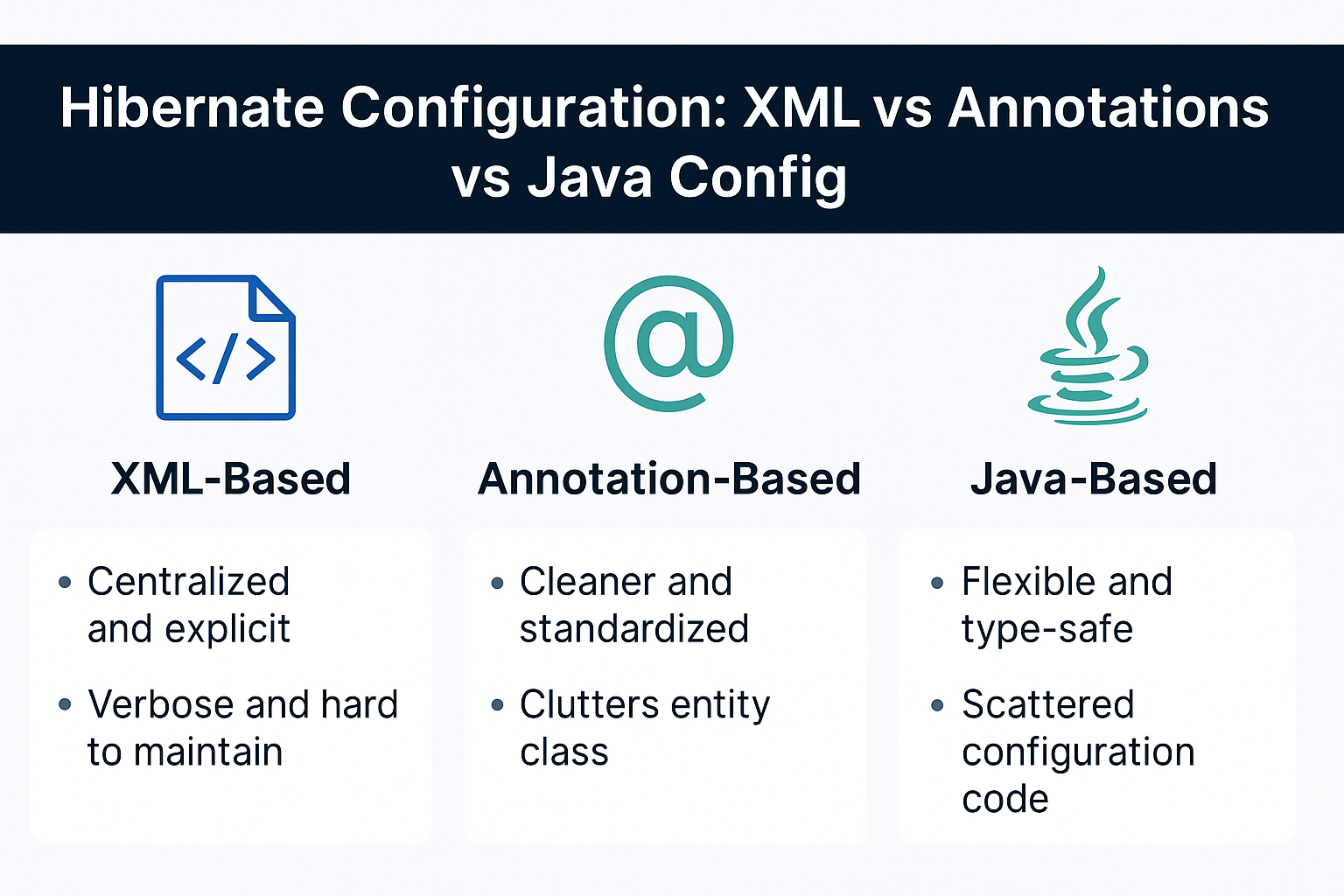Hibernate is one of the most widely used Object-Relational Mapping (ORM) frameworks in Java. To use it effectively, developers need to configure Hibernate properly. Over time, Hibernate has evolved to support three main configuration approaches:
- XML-based configuration (traditional)
- Annotation-based configuration (modern and concise)
- Java-based configuration (programmatic and flexible)
Understanding the differences between these approaches is crucial for designing maintainable and production-ready applications. In this guide, we’ll compare XML vs Annotations vs Java Config, provide complete examples, discuss best practices, and highlight pitfalls.
Hibernate Configuration Approaches
1. XML-Based Configuration
XML was the earliest method for setting up Hibernate. It uses hibernate.cfg.xml for global settings and .hbm.xml for entity mappings.
hibernate.cfg.xml
<hibernate-configuration>
<session-factory>
<property name="hibernate.connection.driver_class">com.mysql.cj.jdbc.Driver</property>
<property name="hibernate.connection.url">jdbc:mysql://localhost:3306/testdb</property>
<property name="hibernate.connection.username">root</property>
<property name="hibernate.connection.password">root</property>
<property name="hibernate.dialect">org.hibernate.dialect.MySQL8Dialect</property>
<property name="hibernate.hbm2ddl.auto">update</property>
<property name="hibernate.show_sql">true</property>
<mapping resource="student.hbm.xml"/>
</session-factory>
</hibernate-configuration>
student.hbm.xml
<class name="com.example.Student" table="students">
<id name="id" column="id">
<generator class="identity"/>
</id>
<property name="name" column="student_name"/>
</class>
Pros:
- Centralized and explicit.
- Good for legacy projects.
Cons:
- Verbose.
- Hard to maintain in large projects.
2. Annotation-Based Configuration
Introduced with JPA, annotation-based configuration moves mappings directly into Java classes.
import jakarta.persistence.*;
@Entity
@Table(name = "students")
public class Student {
@Id
@GeneratedValue(strategy = GenerationType.IDENTITY)
private Long id;
@Column(name = "student_name", nullable = false)
private String name;
public Student() {}
public Student(String name) { this.name = name; }
// Getters and Setters
}
Updated hibernate.cfg.xml (only core configs)
<hibernate-configuration>
<session-factory>
<property name="hibernate.connection.driver_class">com.mysql.cj.jdbc.Driver</property>
<property name="hibernate.connection.url">jdbc:mysql://localhost:3306/testdb</property>
<property name="hibernate.connection.username">root</property>
<property name="hibernate.connection.password">root</property>
<property name="hibernate.dialect">org.hibernate.dialect.MySQL8Dialect</property>
<mapping class="com.example.Student"/>
</session-factory>
</hibernate-configuration>
Pros:
- Cleaner and easier to maintain.
- Standardized with JPA.
Cons:
- Clutters entity class with mapping metadata.
3. Java-Based Configuration (Programmatic)
Java-based configuration uses Hibernate’s Configuration API or frameworks like Spring Boot.
import org.hibernate.SessionFactory;
import org.hibernate.cfg.Configuration;
public class HibernateUtil {
private static final SessionFactory sessionFactory;
static {
try {
sessionFactory = new Configuration()
.setProperty("hibernate.connection.driver_class", "com.mysql.cj.jdbc.Driver")
.setProperty("hibernate.connection.url", "jdbc:mysql://localhost:3306/testdb")
.setProperty("hibernate.connection.username", "root")
.setProperty("hibernate.connection.password", "root")
.setProperty("hibernate.dialect", "org.hibernate.dialect.MySQL8Dialect")
.addAnnotatedClass(Student.class)
.buildSessionFactory();
} catch (Throwable ex) {
throw new ExceptionInInitializerError(ex);
}
}
public static SessionFactory getSessionFactory() {
return sessionFactory;
}
}
Pros:
- Flexible and type-safe.
- No external XML required.
Cons:
- Configuration scattered across code.
- Less readable for non-developers.
CRUD Operations (Works Across Configurations)
Create
Session session = HibernateUtil.getSessionFactory().openSession();
Transaction tx = session.beginTransaction();
Student student = new Student("Alice");
session.persist(student);
tx.commit();
session.close();
Read
Session session = HibernateUtil.getSessionFactory().openSession();
Student student = session.get(Student.class, 1L);
System.out.println(student.getName());
session.close();
Update
Session session = HibernateUtil.getSessionFactory().openSession();
Transaction tx = session.beginTransaction();
Student student = session.get(Student.class, 1L);
student.setName("Updated Alice");
session.update(student);
tx.commit();
session.close();
Delete
Session session = HibernateUtil.getSessionFactory().openSession();
Transaction tx = session.beginTransaction();
Student student = session.get(Student.class, 1L);
session.remove(student);
tx.commit();
session.close();
Querying in Hibernate
HQL
List<Student> students = session.createQuery("FROM Student WHERE name = :name", Student.class)
.setParameter("name", "Alice")
.list();
Criteria API
CriteriaBuilder cb = session.getCriteriaBuilder();
CriteriaQuery<Student> cq = cb.createQuery(Student.class);
Root<Student> root = cq.from(Student.class);
cq.select(root).where(cb.equal(root.get("name"), "Alice"));
List<Student> results = session.createQuery(cq).getResultList();
Native SQL
List<Object[]> results = session.createNativeQuery("SELECT * FROM students").list();
Caching and Performance Considerations
- Lazy Loading (default) → Loads when needed. Like ordering food only when hungry.
- Eager Loading → Fetches everything upfront.
- First-Level Cache → Session-based.
- Second-Level Cache → Application-wide.
- Query Cache → Speeds up repeated queries.
Real-World Integration with Spring Boot
Spring Boot prefers annotation and Java config:
spring.datasource.url=jdbc:mysql://localhost:3306/testdb
spring.datasource.username=root
spring.datasource.password=root
spring.jpa.hibernate.ddl-auto=update
spring.jpa.show-sql=true
Repository:
public interface StudentRepository extends JpaRepository<Student, Long> {}
Anti-Patterns and Pitfalls
- Using eager fetching everywhere → performance issues.
- Overusing cascade delete → unintended data loss.
- Mixing XML and annotations inconsistently.
Best Practices
- Prefer annotations for new projects.
- Use Java-based config with Spring Boot.
- Keep XML only in legacy systems.
- Always enable lazy fetching unless eager is justified.
📌 Hibernate Version Notes
Hibernate 5.x
- Relies on
javax.persistence. - XML was more common.
- Legacy Criteria API.
Hibernate 6.x
- Migrated to
jakarta.persistence. - Enhanced SQL support.
- Modernized bootstrap and query API.
Conclusion and Key Takeaways
- Hibernate supports XML, annotations, and Java-based configuration.
- XML is legacy, annotations are widely used, Java config offers flexibility.
- CRUD operations and queries remain consistent regardless of configuration style.
- Hibernate 6 modernizes configuration with Jakarta compliance.
- Choose configuration style based on project type and team preference.
FAQ: Expert Hibernate Questions
-
What’s the difference between Hibernate and JPA?
JPA is a specification; Hibernate is a powerful implementation. -
How does Hibernate caching improve performance?
By reducing database hits using session-level and second-level caches. -
What are the drawbacks of eager fetching?
Loads unnecessary data, slows performance. -
How do I solve the N+1 select problem?
UseJOIN FETCHor batch fetching. -
Can I use Hibernate without Spring?
Yes, Hibernate runs standalone with XML or Java config. -
What’s the best inheritance mapping strategy?
Depends:JOINEDfor normalization,SINGLE_TABLEfor speed. -
How does Hibernate handle composite keys?
With@EmbeddedIdor@IdClass. -
How is Hibernate 6 different from Hibernate 5?
Hibernate 6 usesjakarta.persistence, has enhanced SQL and query APIs. -
Is Hibernate suitable for microservices?
Yes, but prefer DTOs and stateless design. -
When should I not use Hibernate?
Avoid in high-performance analytics or batch ETL jobs.
